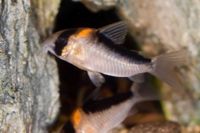Adolfo's Cory (Corydoras adolfoi)
From The Aquarium Wiki
Adolfo's Cory
Corydoras adolfoi
76 Litres (20 US G.)
5-6 cm (2-2.4")
Freshwater
6.0 - 8.0
22 -26 °C (71.6-78.8°F)
2-25 °d
2:3 M:F
3-5 years
Family
Callichthyidae
This animal is available captive bred
Contents
Additional names
- Adolf's Catfish
Additional scientific names
- Corydoras adolfi
Origin
|
|
This section requires expansion with: Location where this animal is found in the wild. |
Sexing
- When properly conditioned, the difference between the male and female Corydoras is usually quite evident. Females will look a lot wider when viewed from the top, as they have a larger underbelly. Males are also shorter in length than females.
Tank compatibility
- Very peaceful community fish. Will not intentionally bother tank inhabitants, however their bumbling about the tank may bother more delicate fish or other bottom dwellers. Are best kept in groups of 5-6 or more.
Diet
- As with most Corydoras, these fish will eat most food which sinks to the bottom of the tank. Sinking algae pellets should be supplemented with flake food or other sinking foods like catfish pellets.
- Be aware these fish do have a carnivorous side to them and love foods such as Bloodworm and Brine Shrimp. Vegetable-based foods offer little nutrition to them. They will also eat any dead, dying, or even injured fish, that sit on the substrate too long. They're very opportunistic!
Feeding regime
- Feed once or twice a day.
Environment Specifics
- Requires a sand or small gravel substrate and prefers a planted tank. Keeping a cory on sharp or large gravel can lead to damage to their barbels, which when infected will make it hard for the cory to find food.
- Corys are sensitive to salt, as with other scaleless fish, adding salt to the tank will cause them harm.
Behaviour
- The Corydoras group of fish frequently gulps air. This is normal and is not a cause for concern. If too little room is available between the water surface and the hood (<2") the fish may hit the hood. They hold the air in their stomach and the thin lining dissipates the oxygen.
- This fish likes the company of its own kind. It is recommended to keep at least 2, or better yet, several of the same species. The more you have, the more secure they are and the more you will see them.
- They are known to 'blink' their eyes to the amazement of onlookers. The Cory has the ability to tilt its eye down to examine the nearby substrate.
Identification
- One of the medium-sized Corys with a white base colour, around the head, covering the eyes, is a black band, this band goes right over the top the head and should be unbroken. Down the spine from the dorsal fin to the caudal peduncle is another black band. In between this band and the one on the head, there can be orange colouration. All fins are clear.
Pictures
External links
- Fishbase (Mirrors:
 )
)
